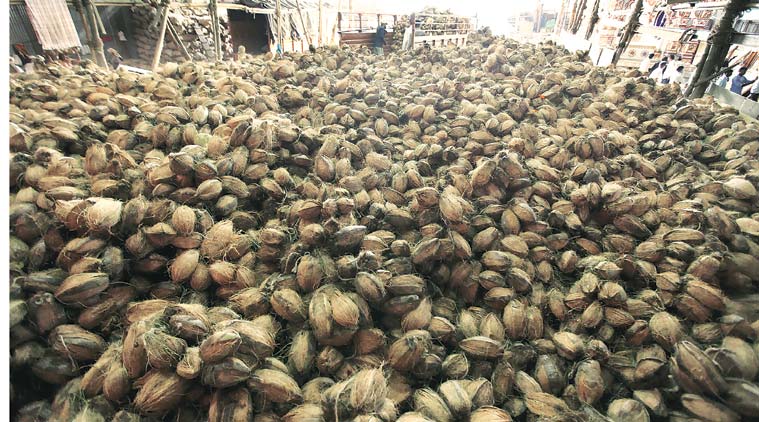Structural composition of coconut may help in understanding energy absorption that could inspire construct earthquake-proof structures
By: PTI | Berlin | Published:July 9, 2016
 Earthquake-proof construction technology might seek inspiration in a rather unexpected source; coconuts. (Representational Picture)
Earthquake-proof construction technology might seek inspiration in a rather unexpected source; coconuts. (Representational Picture)
According to a latest study, the specialised structure of coconut walls may help to design buildings that can withstand earthquakes and other natural disasters.
Coconuts are renowned for their hard shells, which are vital to ensure their seeds successfully germinate. Coconut palms can grow 30 m high, meaning that when the ripe fruits fall to the ground their walls have to withstand the impact to stop them from splitting open.
To protect the internal seed, the coconut has a complex structure of three layers: the outer brown, leathery exocarp, a fibrous mesocarp and a tough inner endocarp surrounding the pulp which contains the developing seedling.
Researchers at the University of Freiburg in Germany studied how this specialised structure could be applied in architecture. They used compression machines and an impact pendulum to study how coconuts disperse energy.
“By analysing the fracture behaviour of the samples and combining this with knowledge about the shell’s anatomy gained from microscopy and computed tomography, we aimed to identify mechanically relevant structures for energy absorption” said plant biomechanist Stefanie Schmier.
The study found that within the endocarp layer – which consists mainly of highly lignified stone cells – the vessels that make up the vascular system have a distinct, ladder-like design, which is thought to help withstand bending forces. Each cell is surrounded by several lignified rings, joined together by parallel bridges.
“The endocarp seems to dissipate energy via crack deflection” said Schmier. “This means that any newly developed cracks created by the impact don’t run directly through the hard shell,” she said.
It is thought that the angle of the vascular bundles helps to “divert” the trajectory of the cracks. The longer a crack has to travel within the endocarp, the more likely it is that it will stop before it reaches the other side.
The distinct angle of the vascular bundles in the endocarp could be applied to the arrangement of textile fibres within functionally graded concrete, to enable crack deflection.
“This combination of lightweight structuring with high energy dissipation capacity is of increasing interest to protect buildings against earthquakes, rock fall and other natural or humanmade hazards,” said Schmier.



.jpg)
.jpg)



0 comments:
Post a Comment